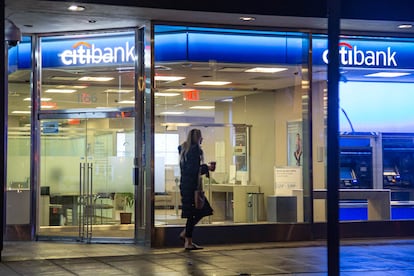Error by Citi trader causes European stock markets to lose €300 billion in minutes
The US bank acknowledges the mistake caused Sweden’s benchmark OMX 30 to fall by 8% and spread to other exchanges, although these rallied back quickly again


A mistake by a single stock trader caused a €300 billion ($315 billion) flash crash in the European markets on Monday. The US-based Citi group acknowledged on Monday night that one of its traders had triggered a sudden, sharp fall in European shares in a matter of minutes, with an equally rapid recovery afterwards.
The Reuters news agency reported in an exclusive story that the US banking group was behind this collapse, and Citi ended up confirming that one of its traders “made an error when inputting a transaction.” The statement added that “within minutes, we identified the error and corrected it.”
A few minutes, however, go a long way on the trading floor. The epicenter of the shock was the Swedish Stock Exchange. The OMX index, the country’s main reference, fell shortly before 10am, registering a drop of up to 8%; shares in fashion firm H&M and the telecommunications company Telia retreated by 10% in a matter of minutes.
Besides having a lot of automated functions, the markets work a bit like a herd. The effects of that single error by a Citi trader did not stop in Sweden. The contagion effect was felt in stock exchanges throughout Europe, the only ones that were open at the time. Spain’s blue-chip Ibex 35, for example, lost 200 points all of a sudden, a drop of more than 2.3%. And European stock markets as a whole lost over €300 billion as a result of the so-called Nordic flash crash.
At the London trading desk
Stocks rallied quickly and in a matter of minutes were back to where they started. Nasdaq Stockholm clarified that the crash was not due to a technical failure. Everything pointed to human error. According to unnamed financial sources cited by Bloomberg, the trader who made the mistake works at Citi’s London trading desk.
Sharp falls in prices often automatically trigger sell orders to limit losses when certain levels are breached. The most notorious case of an instantaneous crash took place in 2010 in the US, when indices like the S&P 500, Dow Jones Industrial Average and Nasdaq Composite Stock Exchange slumped suddenly. On that occasion the flash crash was not triggered by an error but by fraudulent operations that were amplified by algorithms. There were shares that went from trading at $74 to less than a cent in a matter of minutes.
The Singapore Stock Exchange in 2013, the British pound in 2016 and the Ethereum cryptocurrency (which went from $300 to 10 cents in minutes) in 2017 have seen similar episodes of sharp drops followed by immediate recoveries.
Citi has not provided information on whether or how many losses its trader’s error has caused the banking group to incur.
Tu suscripción se está usando en otro dispositivo
¿Quieres añadir otro usuario a tu suscripción?
Si continúas leyendo en este dispositivo, no se podrá leer en el otro.
FlechaTu suscripción se está usando en otro dispositivo y solo puedes acceder a EL PAÍS desde un dispositivo a la vez.
Si quieres compartir tu cuenta, cambia tu suscripción a la modalidad Premium, así podrás añadir otro usuario. Cada uno accederá con su propia cuenta de email, lo que os permitirá personalizar vuestra experiencia en EL PAÍS.
¿Tienes una suscripción de empresa? Accede aquí para contratar más cuentas.
En el caso de no saber quién está usando tu cuenta, te recomendamos cambiar tu contraseña aquí.
Si decides continuar compartiendo tu cuenta, este mensaje se mostrará en tu dispositivo y en el de la otra persona que está usando tu cuenta de forma indefinida, afectando a tu experiencia de lectura. Puedes consultar aquí los términos y condiciones de la suscripción digital.
More information
Últimas noticias
Most viewed
- Sinaloa Cartel war is taking its toll on Los Chapitos
- Oona Chaplin: ‘I told James Cameron that I was living in a treehouse and starting a permaculture project with a friend’
- Reinhard Genzel, Nobel laureate in physics: ‘One-minute videos will never give you the truth’
- Why the price of coffee has skyrocketed: from Brazilian plantations to specialty coffee houses
- Silver prices are going crazy: This is what’s fueling the rally










































